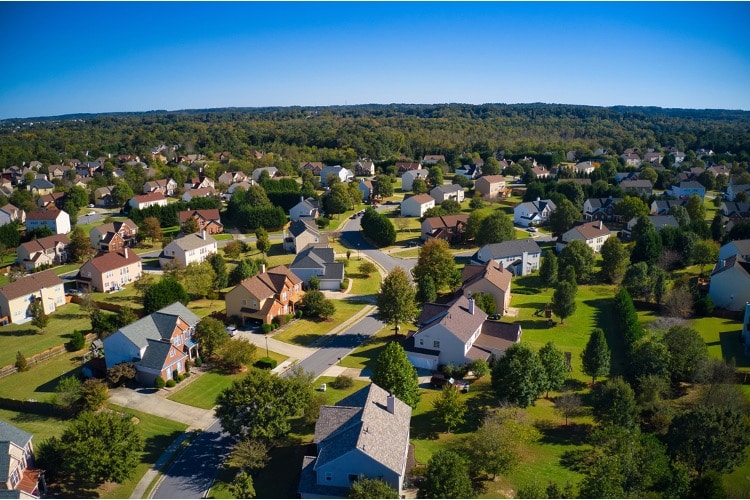
It seems as if Archie Bunkers are everywhere today — only, their prejudice has gone woke.
Bunker, the seasoned among us may know, was the famously amusing ’70s sitcom bigot in hit show All in the Family. Apropos to the story here, in one episode Archie was apoplectic because a black family was poised to move in to his all-white Queens neighborhood. His attitude was meant to be considered unenlightened, the epitome of risible racism born of ignorance. But much has changed in 50 years.
Now being upset about your neighborhood’s changing demographics is considered enlightened — if it’s the “wrong” kind of change. What kind would that be?
Well, leftists, who detest Archie Bunker-like bigotry, have a name for it: “whitewashing.”
Oh, it has also been called a “bleaching out.”
In another case of art imitating life, this casual-bigotry reality is reflected in a new television work: Amazon Prime Video’s The Horror of Dolores Roach. The show concerns the main character, Dolores, who emerges from a stretch in prison to find her Washington Heights, NYC neighborhood transformed.
“Her hangouts have been replaced by chichi cafes and white trust-fund couples occupy the apartments where Dominican-Americans used to live,” writes The Guardian, in a negative review. “The bodegas have been replaced by bespoke [custom-made-clothing] shops,” adds the Los Angeles Times’ Lorraine Ali, “and the sidewalks are filled with folks who look like they stepped out of Lululemon ads.”
One thing leads to another and, to make a short story even shorter, Dolores becomes a serial killer who, with the help of a butcher friend for whom she works, turns the corpses into “‘secret recipe’ empanadas.”
In case there’s any doubt about the message, Ali and the actress playing Dolores, Justina Machado, make it clear. “Here, cannibalism is a metaphor for the whitewashing of a neighborhood, stated Ali while interviewing the performer. “Gentrification cannibalizes what came before it, so why not turn the offending cannibals into tasty fried snacks? It’s a darkly funny way of satirizing urban reality.”
“Absolutely,” replied Machado. “But we’re not hitting anybody over the head with some message.”
And that’s what makes it more effective — it’s what’s assumed that’s learned best.
But what is the message about different people moving to where you’ve long lived and completely transforming the demographics and culture? (Hmm, could indigenous Europeans even imagine what that’s like?) That it’s a bad thing? That it’s understandable if it makes a longtime resident uncomfortable or even angry? This certainly wasn’t the message with Archie Bunker.
These dichotomous analyses are evident in real life, too. Just consider that in 2015, The New York Times reported on what it called the “gentrification” of San Francisco’s Mission District neighborhood. Primarily white dotcommers — Facebook founder Mark Zuckerberg among them — were buying real estate, moving in, and raising property values in the formerly Hispanic area. Nonetheless, as American Thinker wrote in response, “Nowhere in this article did the Times ever use the word ‘diversity.’ This is puzzling, because in every other article where they talk about adding more Blacks or Hispanics to a white population, they always celebrate that as the merits of diversity.” But then there’s what the Times did do: It described the Mission’s demographic change as the “bleaching out” of its “Latino culture.”
Ironically, pugnacious pundit Ann Coulter was also in the news at the time, promoting a book about how our immigration regime was (and is) creating a historically unprecedented, nation-changing demographic upheaval. And Coulter, not one to cower from controversy, called change the “browning of America.”
Left-wing Daily Beast writer Lloyd Grove responded to this, writing that it is “language that many doubtless will find hair-raising if not downright offensive.” Yet as he also confessed, it’s merely a phrase Coulter “adopted as a negative after seeing it bandied favorably on MSNBC.” And, of course, the leftist media would never use such language unfavorably.
Except, that is, when talking about “whitewashing” or “bleaching out.”
How it works is simple: When a town transitions from 4.9 percent Hispanic in 2000 to almost 60 percent now, as Hazelton, Pennsylvania, has, it’s good. When the United States’ non-Hispanic white population declines from approximately 87 percent in 1967 to today’s ≈60 percent, it’s blessed diversity delivered by enlightened (im)migration policy. But when it’s the reverse, it’s a tragic loss of culture (and maybe, even, neighborhood “appropriation”?).
Because, you see, when “gentrification” (a negative propaganda term) occurs, terrible things happen. A neighborhood becomes cleaner and is beautified, schools improve, crime falls, and property values rise. Those darned Caucasians!
But here’s the kicker: In San Fran’s Mission District, the Hispanics originally displaced the first Mission settlers: Jews, Irish, and other mainly white groups. As for Dolores Roach’s Washington Heights, it was occupied by Dutch-descent Americans long before Latinos ever arrived. In fact, NYC was upwards of 98 percent white in 1900; meaning, the “whitewashing” of any or virtually any neighborhood there is merely, in a way, a matter of it recapturing its roots.
Yet the reality is, as American Thinker editor Thomas Lifson put it in 2015, “Nobody owns a neighborhood forever.” But because the Left owns the narrative, whites can do nothing right. If they become experts in and purveyors of exotic food, they may be accused of cultural appropriation. But if their toddlers say “yuck” in response to the same food, the child could be guilty of “racism.” Dressing as minority characters makes whites insensitive, but not having enough minority characters in their movies makes them, well, insensitive. If they depart “browning” areas, it’s “white flight,” and destructive, because it robs cities of much needed wealth and impoverishes neighborhoods; and if they later return to those areas, it’s destructive because it robs cities of cheap digs and enriches neighborhoods. And what do you call this — this double standard?
They call it white privilege.



















































